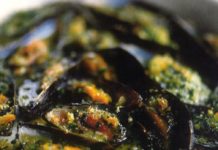
Basic Pasta Dough
The ideal proportions for the best home-made pasta dough are one large egg for every 115g (4oz) flour, but variations in temperature and humidity as well as in the in the ingredients themselves may produce slightly different textures. You may need to vary the quantity of flour slightly: the thing to aim for is a dough which has been kneaded until it is perfectly smooth and elastic, yet firm.
[mpprecipe-recipe:9]Video: Make fresh pasta in five easy steps the Carluccio’s way











